THE OPENING is all about introducing the fascinating, quirky and wonderful people working in and around the visual arts in Vancouver.
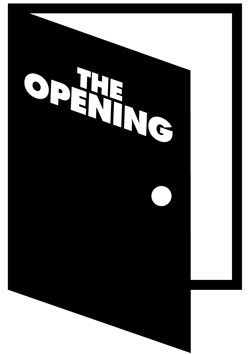 |
|
THE OPENING is all about introducing the fascinating, quirky and wonderful people working in and around the visual arts in Vancouver. Each week, we’ll feature an artist, collective, curator or administrator to delve deep into who and what makes art happen! |
Artist Scott Massey works with light, most often using photography, sculpture or both to conjure ideas about space - from that which surrounds us everyday in our urban lives to the unknown bodies above us most often contemplated by telescope. He will be completing two new installations as part of the Contemporary Art Gallery's upcoming exhibitions. Massey and I sat down over beers recently to discuss his interest in space and light, the difficulties of being a photographer in Vancouver, and the aforementioned installations.
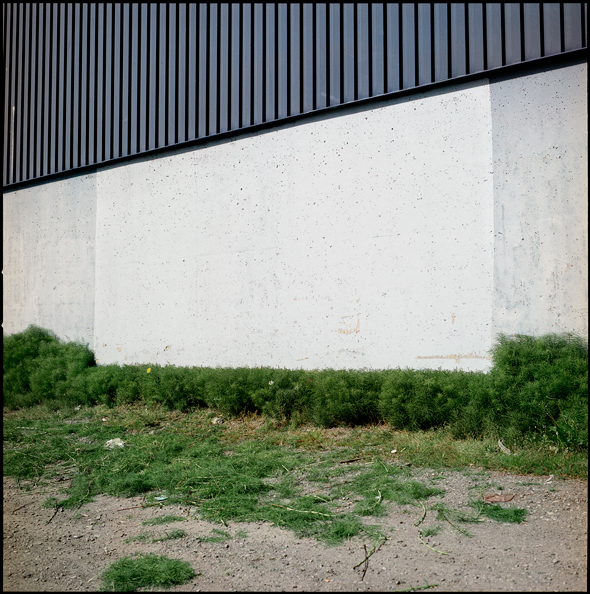
'Buff Frame' 2006, from 'Minor Incidents' series. Enlarger colour print, 30x30"
You often alter or amplify something that already exists, whether natural or unnatural, sometimes accentuating an existing intervention. Why these interventions?
So often people navigate their way through the world without taking much notice. I find it kind of fascinating that with a very subtle intervention, you can totally change the reading of the scene and change people's awareness of it. With the
Minor Incidents series, I wanted to know what the smallest change I could affect was that would have some significance. What I needed to identify was the most poignant aspect of a scene. By changing that thing, it became obvious that even a subtle change was going to have larger implications.
It was also about the degree to which we operate with very little knowledge of the world. What happens when we flood environments with 24-hours of light? It changes things. The amplifying of something is really a way of saying "Hold on, what are we missing here?" Repercussions have occurred because of a circumstance we're creating. What's the trade-off for that circumstance? So the altering is heightening an awareness of things that already exist.
In terms of what it is that you change in any given landscape, do you often find yourself drawn to certain things over others?
That's part of the wandering process. If I go back to the
Minor Incidents works... what happens with those is I wander around until something hits me. I don't go out with this idea that I need to find a certain scene to enact a pre-meditated reaction to it. That's why those were very interesting in the sense that if something happened it happened, and if it didn't, it didn't. I couldn't force it. Most of the time I would have some success with that, to a greater or lesser degree. Usually there's something interesting to be found, pretty much anywhere. I think Orozco is a good example of someone who can navigate a completely banal environment but touch on something and twist it just enough that it all comes out of that little action. The Arte Povera artists, that was their intention, bridging that gap and bringing art to the masses as something that we should experience on a regular basis. That it's not only housed in museums, that it can be anywhere.
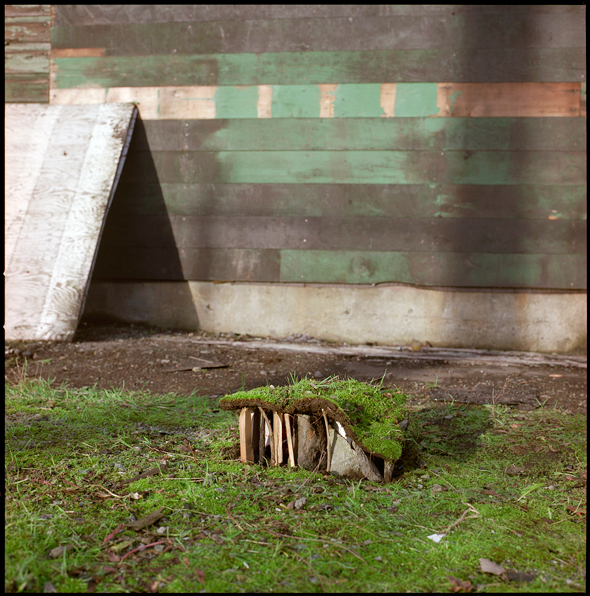
'Square Foot Elevation' 2007, from 'Minor Incidents' series. Enlarger colour print, 30x30"
So you're trying to find the art in the everyday?
With that series, absolutely. I'm not saying that's an overriding concern in all of what I do because it's not. With other things, if I think about
Rememeration Piece #1, that was more about recognizing the effects of electric light on natural growth processes. Most people could care less if a tree was dropping its leaves a month later than it normally would and we don't know if that's an important repercussion. It is a repercussion; there is a reaction to that change in the environment. So at what point do we say that it's meaningless or not worthy of our attention, or that's fascinating and what does it mean? How does that play out in a larger scenario?
Would you consider yourself an activist?
That's interesting that you bring that up because I used to. I came to photo-based landscape work very much an activist. I realized eventually that art was a pretty shitty vehicle to affect any lasting or positive change. It was also very limiting. It said if I get stuck into a box of being the activist artist, how then do I deal with all the other ideas and things that interest me and things that concern me that aren't really about being an activist or being an environmentalist or being an -ist? How can I still pay attention to those very important parts of my practice? I needed to reframe my approach and realize that if I wanted to be an activist that it's actually another vocation apart from art. To force art to only do that thing is way too limiting. I had to decide at that point.
So art over activism?
Yeah... I've still got sensitivities to activism, but I want to make art. Being an activist artist is too easy a limitation, why would you do that?
What is your relationship to the landscape?
Landscape is such a charged medium. I've always had a strong affinity for the genre. The whole reason I went to art school was because of Richard Long's
A Line Made by Walking. That was an epiphany for me. I think he could have stopped at that, I don't know how he could have bested it. He made that while he was in art school. It kind of sums up our relationship with nature - it's all right there. It was amazing to me. It suddenly made me understand art, just seeing that and accepting it. I think a lot of art is about just accepting the work, and that's how we can appreciate it.
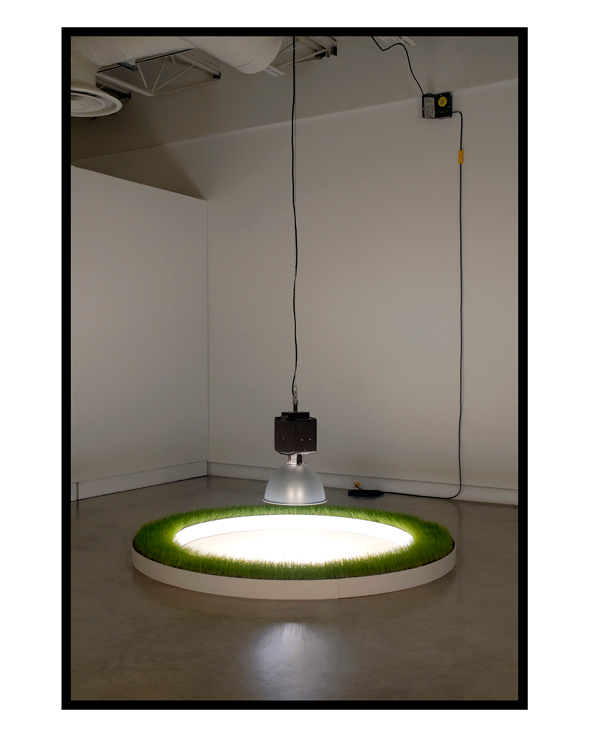
'Rememoration Piece 1' 2004. Industrial lamp, full spectrum bulb, timer, ring planter, grass seed, soil. Dimensions variable.
Later I came across the work of the New Topographics. It was all about the relationship to the land and the anthro-centric domination of the landscape. It went from Ansel Adams and the pristine landscape to the New Topographics where they said the pristine landscape was bullshit. There are coke cans in your moonrise over Yosemite, candy wrappers... this idea of pristine wilderness without man doesn't exist anymore and is done. Those were profound and seemed to be the basis of a lot of work that was coming out of Vancouver - Roy Arden, Christos Dikeakos, Arni Haraldsson. I played on those themes too. The New Topographics show was really about how we alter the landscape. There was a recent show at Presentation House Gallery about the man-altered landscape, about how we are changing ideas of landscape, and how we've changed the landscape and how we represent those changes. I was playing on those themes with the work I did for the series
Crepuscule. My subject for those was more a McLuhan-esque reading of the power of electric light upon the landscape rather than documenting the landscape. Arden was documenting the transformation of the landscape. Haraldsson was doing similar things. With my work it was really about just the impact that electric light was having because it was saying we don't care when the sun goes down. We don't care what month it is or what season is going on or how hot or how cold it is. We can affect a change on that, we have electric light, we can just keep going. No matter how far you were progressing, electric light was always going further. It was always ahead of you. For me it was always illuminating the future. That's why the photos in the series are all about the unaffected landscape that is about to be infiltrated. With those works, which happened in tandem with the grass ring work for Artspeak, that's when I realized that just light itself seemed to be pretty important in so many of my works. It winds its way through almost everything that I do. I don't mean for that to happen all the time.
And you are primarily using a light-based medium.
Absolutely. I have to obviously contend with it. It's more than just a relationship with light as a property that I need to negotiate onto the film or the camera, but as an agent.
Is photography your preferred medium?
I've always felt that photography was my favourite tool to work through ideas, but not necessarily my preferred medium. I always felt that it was a bit limiting. When I look back at the art that I've made, there always seems to be this relationship between photography and something else. Mostly it is sculpture or sculptural installations. The show I had at Artspeak, the photos were all about landscape, but they were also about the invisible aspects of landscape and how to photograph or document something that isn't actually there. I was shooting something that was fully inherent in the image but it wasn't actually there. But again there was a sculpture attached to it. The sculpture set up this really basic dialogue, because I was saying something completely different but not unrelated to the photos. This idea of playing off of two mediums was more interesting than just photos. So I wouldn't say it's my primary medium, but it is my primary tool of working.
Sculptural installation has been very important, and I've been lately getting into video as well. That's opening up all kinds of possibilities. Photo is kind of restrictive. It's especially problematic to be a photo-based artist in Vancouver. There's a lot of pressure there. I think ultimately Vancouver produces better photographers for it because you can't get lazy or sloppy. In that sense it's amazing. On the other hand, that's a formidable amount of pressure. It's very difficult to create a photographic image without the history of photo in Vancouver pressing upon you. Sometimes that's okay and sometimes it's not.
Do you feel that's because everybody treats photography in the same manner?
No, not exactly. I feel badly, because Ian Wallace, Roy Arden, Jeff Wall and Stan Douglas kind of get lumped together in this group called photo-conceptualism or the Vancouver School or whatever... that must be the most irritating thing. It's an easy wash. The critics, writers, theorists, and educators can contain that thing and push it around as some kind of cohesive unit. But if you look at their work the cohesion is just not there. They're all working with photos and they're all doing image-based work but it's so incredibly different. I think it's a disservice to lump them all together under some sort of generic headline like photo-conceptualism. As much as it has been amazing and put Vancouver on the map, and I'm benefiting being a photo-based artist in Vancouver as others are, I think they are probably suffering for it.
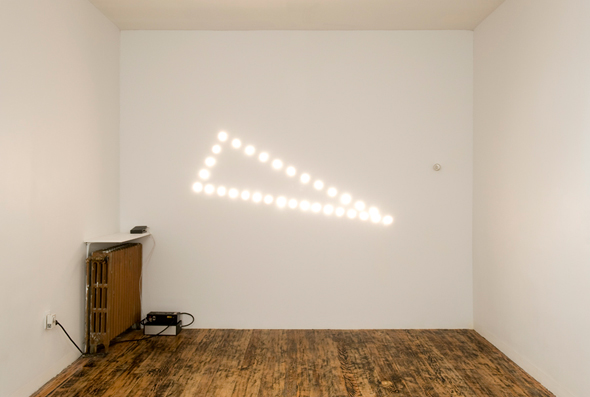
'33 Views of M33' 2010, installation view at CSA Space. Laser engraved tungsten bulbs, porcelain lamp holders, wiring, light sensor and arduino circuit. Dimensions variable.
For you, what is the difference between a documentary photograph and an artistic photograph?
I understand the desire to separate these ideas. It always depends on context. In terms of existential transcendence... if we think about art there is always for me a necessary relationship with transcendence. So in terms of that existential transcendence, the Hubble deep field image is for me probably the most important photograph ever made. It is certainly a document and a record, and probably few people would call it artistic in any way, but when you understand the implications of it, it's hard to compete with. So for me it really is about the context of those two things. History plays a really big role in it too. I think the same image can go through iterations of both depending on time, context, relationship to others...
So would you consider your work more along the lines of document or artistic or both?
To some degree it has to be both. It's the nature of photography - it's a document or a record of a moment that existed in time. Sontag talks about this way better than most people have since. So the question would have to be then, what makes a photograph - which has to be a document as it's inherent in the medium - enter the realm of the artistic? I would say it's about context, about reading. If I'm by necessity creating a document when I take a photograph, then I am by necessity creating an artwork by the way that I frame the document, by the way that I enter into a dialogue that exists or have created a new one. Or simply by the way I choose to display it - the context could just be that it's in a gallery. There have been a number of incidents where a purely documentary record has been placed in a gallery and its reading changes because of that. I would say that there is nothing wrong with that, there is no value judgment to be made for its ability to change. Everything does.
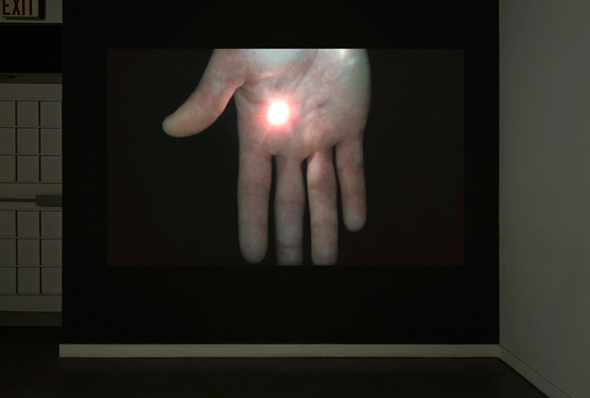
'Torture Box' 2009. HD video
Let's talk about your upcoming exhibit at the Contemporary Art Gallery, which includes the installation at Yaletown-Roundhouse Station.
The piece at Yaletown-Roundhouse is the second in a series that I'm currently working on called
Via Lactea, which is the Latin translation for Milky Way. It's a series that I intend to continue indefinitely. They are really difficult to make because I have to be really far away from civilization. It also has to be a really clear night on a new moon... so I have a 4-5 day window around the new moon. None of the works have actually been made in Vancouver because it would be impossible. The closest I've been is off Coldwater Road on the Coquihalla. For the first one I was about 45 minutes away from the nearest town... and we're talking a town. Even then, the light pollution coming from the town was colouring the edge of the horizon to one side all night. The second attempt was done truly far from anything. It was more effective but it took longer.
Basically what I did was get the longest lense I could find for a Hasselblad. I hiked out to wherever I needed to be with my equipment, and then started setting up at around dusk and hunkered down until it started getting dark enough for stars to come out. That is usually about an hour and a half to two hours after sunset. Then I start shooting, which takes me about all night. I go as long as I can stand or as long as there is darkness. Then I take one small photograph directly overhead, and then I start doing concentric circles of photographs all the way until I'm scanning the horizon over a whole bunch of photographs. The photo at Yaletown-Roundhouse is actually made up of 171 photographs, all put on the same piece of film.
When I was running tests, I had to determine what the longest exposure was that would give me nice starlight but not produce any tracking from the movement of the Earth. I came up with 4 seconds as the longest exposure. So I did these tests, but I realized it wasn't really interesting to have white stars on a black background. So what I thought I could do was ask my lab to stick the transparency (I had shot on slide or positive film) into an enlarger, which you don't do with slide film. And I asked them to print it with whatever standard settings they would use for a negative photograph. They came back with this amazing beautiful blue colour with black dots all over it. I was just astounded. It was exactly a daytime sky. At that point I had shot my first test of the actual series on print/negative film. When I got the print film back I asked them to scan it as if it were a transparency. So reversing the previous process. And again I got that beautiful sky blue but with the white dots in the sky. A few days later I was reading somewhere that with a powerful enough telescope, you can actually see the stars in the daytime. It makes sense because they're still there, it's just that our star is overpowering them. I think we forget that, but to me it's an amazing thing.
As for the window installation at the CAG itself, The work is titled
Aurorae, after Aurora the goddess of dawn in Roman mythology, here multiplied and continuously repeated. I will say no more and let it and the relationship with the skytrain work unfold as it will.
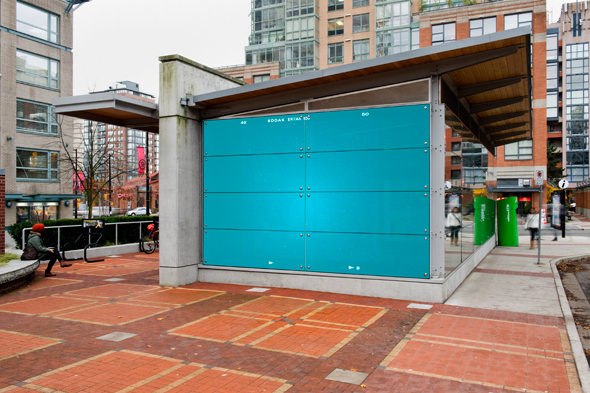
'Via Lactea (above Glacier Lake)' 2011, installation view at the Roundhouse Skytrain Station, Vancouver.
Scott Massey lives and works in Vancouver. He received his BFA in photography from Emily Carr University of Art and Design in 2003. His work has been exhibited at CSA Space, Vancouver; Artspeak, Vancouver; Luminato Box, Luminato Arts Festival, Toronto; Contact Photography Festival, Launch Projects, Toronto; Gallery 44, Toronto; Columbus College of Art & Design, Ohio; and 2010 Arte Laguna, Venice.
Aurorae will be shown at the
Contemporary Art Gallery from February 3 - April 15, 2012, and
Via Lactea (above Glacier Lake) will be installed at Yaletown-Roundhouse Station from February 3 - June 30, 2012. For more information on his work, please visit
scottmassey.ca.
All images courtesy Scott Massey.









